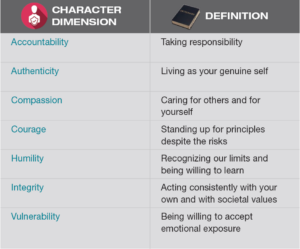Amy Newman is a senior lecturer emerita from Cornell University, SC Johnson College of Business, and author of Business Communication and Character, 11e and Building Leadership Character.
We want students to be better people — not just to learn Accounting or Art History, but to make good decisions that affect others in positive ways. But faculty members brave enough to schedule an “ethics” lesson on their syllabus often experience blank stares when breaching the subject in class. So, how do we engage students in ethics lessons and encourage better decisions? Here are a few ideas for focusing on building results, values, and character in students instead of having them just memorize course material.
Reframe “ethics” to “decisions,” “outcomes,” or “results”
From their experience, students might picture what a class session titled “ethics” looks like. To avoid that baggage, you can opt out of using the term entirely. Discuss “decisions” students make and how those decisions affect others. Encourage them to identify everyone who might be affected by a decision — those they know and those they don’t know — and to identify potential “outcomes” for each. Ask students to consider “long-term results,” including unintended consequences if they take a particular action.
Change theoretical cases to applied situations
Research shows that using theoretical case examples for students without any real-world connection can be risky. When faculty ask students to discuss vague, ethical situations, we set up an intellectual debate without tangible ideas. In these situations, students tend to rationalize their own point of view, which could more deeply entrench their thinking in a single point of view.
Instead, Mary Gentile, former Professor of Ethics at the University of Virginia Darden School of Business, and others believe that students want to do the right thing but need practice. With practice, they develop “moral muscle memory,” making it easier for them to choose ethical action in the future. Choose exercises that challenge students to rehearse ethical behavior in practical terms. To get started, you can find a wealth of free activities and assignments in Darden’s Giving Voice to Values curriculum.
Focus on values
Unlike ethics, which vary by profession or group, values are more personal. Students may be more interested in identifying — and more committed to following — principles influenced by their family background, culture, religion, or community.
Students can identify their values quickly using a simple process, and you can refer to their values throughout a course. For example, how does valuing curiosity affect how students approach learning new concepts? How does valuing risk-taking affect how they choose or tackle assignments? How does valuing loyalty affect their teamwork? How does valuing ambition or family affect their career choices? How does understanding their own and others’ values diffuse or create conflict?

A chart showing different sets of values, and how they’re defined. (Business Communication and Character, 11e, Figure 1, p. 5)
Discuss character
When I started teaching Business Communication, I thought that most career failures were caused by communication failures (something about having a hammer, I suppose). Over time, my interest evolved toward character, particularly in helping students develop better judgment.
I focus on character in the newest edition of my book, Business Communication and Character, 11e, and introduce seven character dimensions that can be integrated into any course. To help students make decisions, I developed the CAM model.
Students first Check their Character by considering their own motivations and goals. Next, they Analyze their Audience and the context for their decision. Finally, they decide on content for their Message and choose a Medium to use. To get students started with this discussion, download the worksheet and sample activity I created.

A diagram of the CAM process (Business Communication and Character, 11e, Figure 2, p. 6)
Add reflection to assignments
Asking students to reflect on their choices reinforces their ethical decisions. During an internship or team project, ask them when they demonstrated the courage to speak up against something that conflicted with their values. They should also consider what about their field experience made them question their values, if they felt vulnerable and if this improved relationships in some way, and how they held themselves or others accountable.
When reporting their research, how did your students avoid showing skewed data to demonstrate integrity? Did they check their assumptions and biases? Why did they include certain information despite potentially weakening their argument? How did they demonstrate compassion or humility when working with others? By considering these questions, students confront and reflect on their actions, and learn more about their moral compass and sense of ethics.
Explore additional resources
Talking about ethics is difficult for both faculty and students. Focusing on students’ values and character and giving them opportunities to make ethical decisions will strengthen their resolve when faced with challenging choices in the future.
With Business Communication colleagues, I put together a workshop deck, sample assignments and activities about ethics, values, and character. For more information, I suggest reading about the Leader Character Framework, developed by Ivey Business School researchers.
To learn more about strategies for teaching ethics, check out Amy Newman’s full title, Business Communication and Character, 11e.

